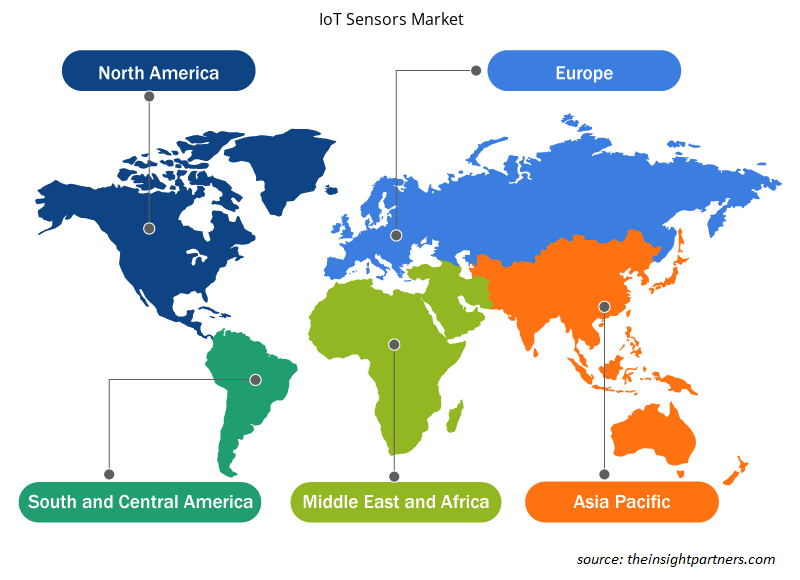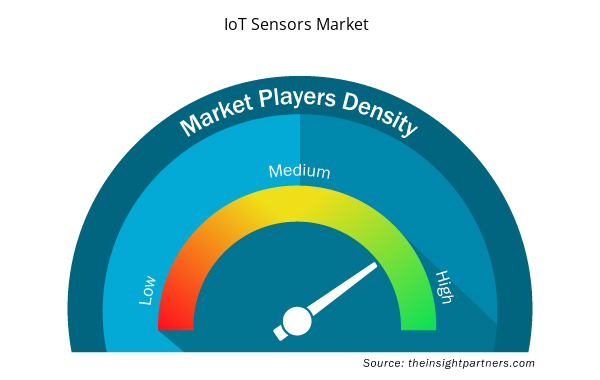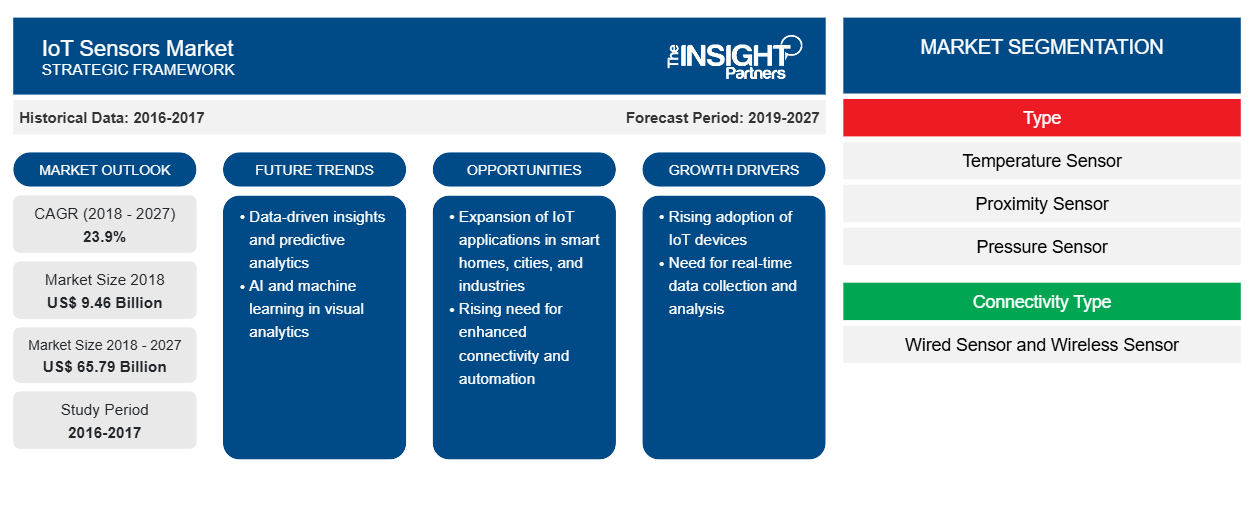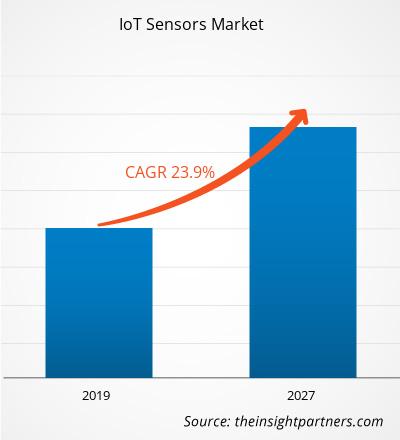بلغت قيمة سوق أجهزة استشعار إنترنت الأشياء 9.46 مليار دولار أمريكي في عام 2018 ومن المتوقع أن تنمو بمعدل نمو سنوي مركب قدره 23.9٪ خلال الفترة المتوقعة 2019 - 2027، لتصل إلى 65.79 مليار دولار أمريكي بحلول عام 2027.
كانت أمريكا الشمالية هي السوق الرائدة لأجهزة استشعار إنترنت الأشياء في عام 2018 ومن المتوقع أن تشهد منطقة آسيا والمحيط الهادئ أسرع نمو طوال فترة التوقعات. في جميع أنحاء أمريكا الشمالية، أدت التطورات التكنولوجية إلى أسواق شديدة التنافسية. تعد أمريكا الشمالية مركزًا للتطورات التكنولوجية التي تضم دولًا قوية اقتصاديًا. تعمل الشركات باستمرار على تحسين العمليات التجارية الشاملة من أجل تلبية طلب العملاء على المنتجات والخدمات عالية الجودة بأفضل طريقة ممكنة. نظرًا لكونها دولة متقدمة تقنيًا، إلى جانب ارتفاع الدخول المتاحة للأفراد، فقد ازدهرت صناعة الإلكترونيات الاستهلاكية في المنطقة. كثافة الأجهزة الإلكترونية الاستهلاكية في المنطقة عالية جدًا. دفعت هذه العوامل سوق أجهزة استشعار إنترنت الأشياء في أمريكا الشمالية.
رؤى سوق أجهزة استشعار إنترنت الأشياء
ارتفاع في صناعة الالكترونيات الاستهلاكية
تشهد صناعة الإلكترونيات الاستهلاكية نموًا هائلاً. في السيناريو الحالي، يستخدم المستهلكون في جميع أنحاء العالم العديد من الأجهزة الإلكترونية الاستهلاكية لأداء مجموعة كبيرة من المهام. أصبحت الأجهزة الإلكترونية الاستهلاكية مثل الهواتف الذكية والأجهزة اللوحية وأجهزة الكمبيوتر الشخصية ومشغلات الموسيقى وما إلى ذلك جزءًا لا يتجزأ من حياة المستهلكين. أصبحت الأجهزة الاستهلاكية أكثر ذكاءً مع التقدم التكنولوجي المستمر. لقد أدت التطبيقات التي تعمل بالذكاء الاصطناعي إلى زيادة الطلب على أجهزة استشعار أرخص. ينمو سوق الإلكترونيات الاستهلاكية في السيناريو الحالي، وذلك بسبب حقيقة أن العديد من شركات أشباه الموصلات تبتكر بانتظام تقنيات متقدمة تجذب الصناعة. علاوة على ذلك، تمثل الأجهزة القابلة للارتداء واحدة من أسرع القطاعات نموًا في صناعة الأجهزة المتصلة بإنترنت الأشياء . تعتبر الشركات المتقدمة الأجهزة القابلة للارتداء فرصة استثنائية لتكنولوجيا الهاتف المحمول التي يمكن أن تؤدي إلى زيادة الكفاءة وتحسين سير العمل وتعزيز الاتصال.
قم بتخصيص هذا التقرير ليناسب متطلباتك
ستحصل على تخصيص لأي تقرير - مجانًا - بما في ذلك أجزاء من هذا التقرير، أو تحليل على مستوى الدولة، وحزمة بيانات Excel، بالإضافة إلى الاستفادة من العروض والخصومات الرائعة للشركات الناشئة والجامعات
- احصل على أهم اتجاهات السوق الرئيسية لهذا التقرير.ستتضمن هذه العينة المجانية تحليلاً للبيانات، بدءًا من اتجاهات السوق وحتى التقديرات والتوقعات.
ظهور السيارات المتصلة
تتيح السيارات المتصلة للمسافرين أو السيارة نفسها مشاركة البيانات تلقائيًا داخل السيارة وخارجها أيضًا. إن إنترنت الأشياء (IoT) هو أحد تلك التقنيات التي كانت بمثابة الأساس لتقديم مجموعة جديدة من المنتجات والخدمات لمصنعي السيارات والتي تشكل طبقة جديدة تمامًا لتصورات السيارات التقليدية. قد تتضمن هذه التكوينات الجديدة أجهزة استشعار ووحدات تحكم وإضاءة وتطبيقات برمجية، ويتم تقديم هذه المنتجات والخدمات كمنتجات مستقلة، حيث يمكن للعميل التوصيل والتشغيل حسب المتطلبات أو بعض الميزات مدمجة في سيارات الجيل الجديد. يمكن نشر هذه الأنظمة إما في وحدات المعلومات والترفيه أو وحدات التحكم الآلية للمركبات. إن تقدم الأبحاث في السيارات المتصلة والذاتية القيادة من شأنه أن يزيد من نطاق دمج أجهزة استشعار إنترنت الأشياء في المركبات.
رؤى النوع
يتم تقسيم سوق أجهزة استشعار إنترنت الأشياء على أساس الأنواع تحت مستشعر درجة الحرارة، ومستشعر الضوء، ومستشعر الضغط، والمستشعر الكيميائي، ومستشعر الحركة، وغيرها. يحتاج إنترنت الأشياء إلى أنواع مختلفة من أجهزة الاستشعار لجعل أداء التطبيقات أكثر موثوقية. حيث أن الأشياء ليست قادرة بما يكفي على التقاط الحالات أو تنفيذ الإجراءات ما لم يتم تجهيز جميع الأجهزة أو الأنظمة بأجهزة الاستشعار.
رؤى حول نوع الاتصال
تنقسم سوق أجهزة استشعار إنترنت الأشياء حسب نوع الاتصال إلى سلكية ولاسلكية. ولكل من الاتصالين مزاياه وقيوده التي تميزهما عن بعضهما البعض. الاتصال السلكي أكثر موثوقية وأمانًا، ومن غير المرجح أن يتأثر بالعوامل المحلية مثل الأرضيات أو الجدران أو الخزائن أو الانقطاع من أي أجهزة إلكترونية. في حين أن الاتصالات اللاسلكية هي تقنيات قابلة للتطوير للغاية وفعالة من حيث التكلفة بسبب وجود عدد كبير من الشركات المصنعة في سوق أجهزة استشعار إنترنت الأشياء.
من ناحية أخرى، تفتقر الاتصالات السلكية إلى ميزة التنقل وقابلية التوسع الأفضل. تندرج هذه الاتصالات ضمن فئة باهظة الثمن بسبب تكلفة العمالة وتركيب الأسلاك. إلى جانب ذلك، يكون الاتصال اللاسلكي بطيئًا نسبيًا بسبب التدخل في الإشارات وهو عرضة للتداخل الناجم عن الأجهزة الإلكترونية. لذلك، يختلف الحل المناسب وفقًا لحالة الاستخدام التجاري. يتم تثبيت تقنية إنترنت الأشياء بطرق مختلفة، وبالتالي فهي تعتمد على موقع الأجهزة والموقف. تشمل العوامل المسؤولة عن التأثير على اختيار نوع الشبكة استخدام الطاقة ونطاق الشبكة وقابلية التشغيل البيني وعرض النطاق الترددي للشبكة والاتصال المتقطع والأمان.
لوحظت مبادرة السوق باعتبارها الاستراتيجية الأكثر اعتماداً في سوق أجهزة استشعار إنترنت الأشياء العالمية. وفيما يلي قائمة ببعض الشراكات والتحالفات التعاقدية الحديثة لنشر الحلول التكنولوجية الجديدة:
2019: أطلقت شركة OMRON Corporation ما مجموعه 2512 طرازًا عالميًا من أجهزة استشعار القرب DC 3-Wire E2E NEXT Series، والتي تتميز بأطول مسافات استشعار في العالم (*1) وهي الآن مجهزة حديثًا بميزات إنترنت الأشياء. تقلل هذه المستشعرات من مخاطر توقف المنشأة المفاجئ بعامل 3 (*2)؛ كما أنها تكتشف العلامات التي تحذر من مثل هذه التوقفات وتخطر المستخدمين عبر الشبكة.
2018: كشفت شركة Arm Holdings عن شريحة مخصصة لأجهزة استشعار السيارات ذاتية القيادة. يُطلق على أحدث تصميم لشريحة Arm اسم Cortex-A65AE، وهو مصمم حول فكرة القدرة على التعامل مع تدفق البيانات من أجهزة استشعار السيارات ذاتية القيادة في الوقت الفعلي تقريبًا. تحتوي الشريحة التي تم إطلاقها على ميزات أمان جديدة، بالإضافة إلى ميزات مصممة لمساعدتها في معالجة البيانات ونقلها من أجهزة الاستشعار بسرعة. كما تحتوي على مسار للاتصال السريع بمعالجات الرسومات مثل تلك التي توفرها شركة Nvidia Corp، والتي يتم اعتمادها من قبل شركات صناعة السيارات والتي ستعمل شرائح Arm كمكمل لها.
2017: أضافت شركة NXP شرائح وأجهزة استشعار NFC جديدة لتأمين إنترنت الأشياء. وكشفت شركة NXP عن جهازين NTAG SmartSensors لمراقبة درجة الحرارة والخدمات اللوجستية لسلسلة التبريد ومجموعة NTAG I²C Plus المتوافقة مع Arduino والتي تسمح للمطورين بمحاكاة استخدام شريحة العلامة المتصلة NTAG I²C Plus في نظام إلكتروني مدمج.
رؤى إقليمية حول سوق أجهزة استشعار إنترنت الأشياء
لقد قام المحللون في Insight Partners بشرح الاتجاهات والعوامل الإقليمية المؤثرة على سوق أجهزة استشعار إنترنت الأشياء طوال فترة التوقعات بشكل شامل. يناقش هذا القسم أيضًا قطاعات سوق أجهزة استشعار إنترنت الأشياء والجغرافيا في جميع أنحاء أمريكا الشمالية وأوروبا ومنطقة آسيا والمحيط الهادئ والشرق الأوسط وأفريقيا وأمريكا الجنوبية والوسطى.

- احصل على البيانات الإقليمية المحددة لسوق أجهزة استشعار إنترنت الأشياء
نطاق تقرير سوق أجهزة استشعار إنترنت الأشياء
| سمة التقرير | تفاصيل |
|---|---|
| حجم السوق في عام 2018 | 9.46 مليار دولار أمريكي |
| حجم السوق بحلول عام 2027 | 65.79 مليار دولار أمريكي |
| معدل النمو السنوي المركب العالمي (2018 - 2027) | 23.9% |
| البيانات التاريخية | 2016-2017 |
| فترة التنبؤ | 2019-2027 |
| القطاعات المغطاة | حسب النوع
|
| المناطق والدول المغطاة | أمريكا الشمالية
|
| قادة السوق وملفات تعريف الشركات الرئيسية |
|
كثافة اللاعبين في السوق: فهم تأثيرها على ديناميكيات الأعمال
يشهد سوق أجهزة استشعار إنترنت الأشياء نموًا سريعًا، مدفوعًا بالطلب المتزايد من المستخدم النهائي بسبب عوامل مثل تفضيلات المستهلكين المتطورة والتقدم التكنولوجي والوعي المتزايد بفوائد المنتج. ومع ارتفاع الطلب، تعمل الشركات على توسيع عروضها والابتكار لتلبية احتياجات المستهلكين والاستفادة من الاتجاهات الناشئة، مما يؤدي إلى زيادة نمو السوق.
تشير كثافة اللاعبين في السوق إلى توزيع الشركات أو المؤسسات العاملة في سوق أو صناعة معينة. وهي تشير إلى عدد المنافسين (اللاعبين في السوق) الموجودين في مساحة سوق معينة نسبة إلى حجمها أو قيمتها السوقية الإجمالية.
الشركات الرئيسية العاملة في سوق أجهزة استشعار إنترنت الأشياء هي:
- شركة انالوج ديفايسز
- شركة أرم القابضة المحدودة
- شركة برودكوم
- شركة هونيويل الدولية
- شركة إنفينيون للتكنولوجيا
إخلاء المسؤولية : الشركات المذكورة أعلاه ليست مرتبة بأي ترتيب معين.

- احصل على نظرة عامة على أهم اللاعبين الرئيسيين في سوق أجهزة استشعار إنترنت الأشياء
تجزئة سوق أجهزة استشعار إنترنت الأشياء العالمية
حسب النوع
- مستشعر درجة الحرارة
- مستشعر الضوء
- مستشعر الضغط
- مستشعر كيميائي
- مستشعر الحركة
- آحرون
حسب نوع الاتصال
- سلكي
- لاسلكي
حسب الطلب
- الالكترونيات الاستهلاكية
- أتمتة المباني
- الرعاية الصحية
- السيارات
- صناعي
- بيع بالتجزئة
- آحرون
حسب الجغرافيا
أمريكا الشمالية
- نحن
- كندا
- المكسيك
أوروبا
- فرنسا
- ألمانيا
- المملكة المتحدة
- روسيا
- بقية أوروبا
آسيا والمحيط الهادئ (APAC)
- كوريا الجنوبية
- أستراليا
- الصين
- الهند
- اليابان
- بقية منطقة آسيا والمحيط الهادئ
الشرق الأوسط وأفريقيا
- المملكة العربية السعودية
- جنوب أفريقيا
- الامارات العربية المتحدة
- باقي منطقة الشرق الأوسط وأفريقيا
أمريكا الجنوبية (SAM)
- البرازيل
- الأرجنتين
- بقية سام
نبذة عن الشركة
- شركة انالوج ديفايسز
- شركة أرم القابضة المحدودة
- شركة برودكوم
- شركة هونيويل الدولية
- شركة إنفينيون للتكنولوجيا
- شركة NXP لأشباه الموصلات
- شركة اومرون
- شركة روبرت بوش المحدودة
- شركة إس تي ميكروإلكترونيكس إن في
- شركة تكساس إنسترومنتس
- التحليل التاريخي (سنتان)، السنة الأساسية، التوقعات (7 سنوات) مع معدل النمو السنوي المركب
- تحليل PEST و SWOT
- حجم السوق والقيمة / الحجم - عالميًا وإقليميًا وقطريًا
- الصناعة والمنافسة
- مجموعة بيانات Excel



Report Coverage
Revenue forecast, Company Analysis, Industry landscape, Growth factors, and Trends

Segment Covered
This text is related
to segments covered.

Regional Scope
North America, Europe, Asia Pacific, Middle East & Africa, South & Central America

Country Scope
This text is related
to country scope.
The List of Companies
- Analog Devices, Inc.
- ARM Holdings PLC
- Broadcom, Inc.
- Honeywell International, Inc.
- Infineon Technologies AG
- NXP Semiconductors N.V.
- Omron Corporation
- Robert Bosch Gmbh
- STMicroelectronics N.V.
- Texas Instruments Incorporated
The Insight Partners performs research in 4 major stages: Data Collection & Secondary Research, Primary Research, Data Analysis and Data Triangulation & Final Review.
- Data Collection and Secondary Research:
As a market research and consulting firm operating from a decade, we have published and advised several client across the globe. First step for any study will start with an assessment of currently available data and insights from existing reports. Further, historical and current market information is collected from Investor Presentations, Annual Reports, SEC Filings, etc., and other information related to company’s performance and market positioning are gathered from Paid Databases (Factiva, Hoovers, and Reuters) and various other publications available in public domain.
Several associations trade associates, technical forums, institutes, societies and organization are accessed to gain technical as well as market related insights through their publications such as research papers, blogs and press releases related to the studies are referred to get cues about the market. Further, white papers, journals, magazines, and other news articles published in last 3 years are scrutinized and analyzed to understand the current market trends.
- Primary Research:
The primarily interview analysis comprise of data obtained from industry participants interview and answers to survey questions gathered by in-house primary team.
For primary research, interviews are conducted with industry experts/CEOs/Marketing Managers/VPs/Subject Matter Experts from both demand and supply side to get a 360-degree view of the market. The primary team conducts several interviews based on the complexity of the markets to understand the various market trends and dynamics which makes research more credible and precise.
A typical research interview fulfils the following functions:
- Provides first-hand information on the market size, market trends, growth trends, competitive landscape, and outlook
- Validates and strengthens in-house secondary research findings
- Develops the analysis team’s expertise and market understanding
Primary research involves email interactions and telephone interviews for each market, category, segment, and sub-segment across geographies. The participants who typically take part in such a process include, but are not limited to:
- Industry participants: VPs, business development managers, market intelligence managers and national sales managers
- Outside experts: Valuation experts, research analysts and key opinion leaders specializing in the electronics and semiconductor industry.
Below is the breakup of our primary respondents by company, designation, and region:

Once we receive the confirmation from primary research sources or primary respondents, we finalize the base year market estimation and forecast the data as per the macroeconomic and microeconomic factors assessed during data collection.
- Data Analysis:
Once data is validated through both secondary as well as primary respondents, we finalize the market estimations by hypothesis formulation and factor analysis at regional and country level.
- Macro-Economic Factor Analysis:
We analyse macroeconomic indicators such the gross domestic product (GDP), increase in the demand for goods and services across industries, technological advancement, regional economic growth, governmental policies, the influence of COVID-19, PEST analysis, and other aspects. This analysis aids in setting benchmarks for various nations/regions and approximating market splits. Additionally, the general trend of the aforementioned components aid in determining the market's development possibilities.
- Country Level Data:
Various factors that are especially aligned to the country are taken into account to determine the market size for a certain area and country, including the presence of vendors, such as headquarters and offices, the country's GDP, demand patterns, and industry growth. To comprehend the market dynamics for the nation, a number of growth variables, inhibitors, application areas, and current market trends are researched. The aforementioned elements aid in determining the country's overall market's growth potential.
- Company Profile:
The “Table of Contents” is formulated by listing and analyzing more than 25 - 30 companies operating in the market ecosystem across geographies. However, we profile only 10 companies as a standard practice in our syndicate reports. These 10 companies comprise leading, emerging, and regional players. Nonetheless, our analysis is not restricted to the 10 listed companies, we also analyze other companies present in the market to develop a holistic view and understand the prevailing trends. The “Company Profiles” section in the report covers key facts, business description, products & services, financial information, SWOT analysis, and key developments. The financial information presented is extracted from the annual reports and official documents of the publicly listed companies. Upon collecting the information for the sections of respective companies, we verify them via various primary sources and then compile the data in respective company profiles. The company level information helps us in deriving the base number as well as in forecasting the market size.
- Developing Base Number:
Aggregation of sales statistics (2020-2022) and macro-economic factor, and other secondary and primary research insights are utilized to arrive at base number and related market shares for 2022. The data gaps are identified in this step and relevant market data is analyzed, collected from paid primary interviews or databases. On finalizing the base year market size, forecasts are developed on the basis of macro-economic, industry and market growth factors and company level analysis.
- Data Triangulation and Final Review:
The market findings and base year market size calculations are validated from supply as well as demand side. Demand side validations are based on macro-economic factor analysis and benchmarks for respective regions and countries. In case of supply side validations, revenues of major companies are estimated (in case not available) based on industry benchmark, approximate number of employees, product portfolio, and primary interviews revenues are gathered. Further revenue from target product/service segment is assessed to avoid overshooting of market statistics. In case of heavy deviations between supply and demand side values, all thes steps are repeated to achieve synchronization.
We follow an iterative model, wherein we share our research findings with Subject Matter Experts (SME’s) and Key Opinion Leaders (KOLs) until consensus view of the market is not formulated – this model negates any drastic deviation in the opinions of experts. Only validated and universally acceptable research findings are quoted in our reports.
We have important check points that we use to validate our research findings – which we call – data triangulation, where we validate the information, we generate from secondary sources with primary interviews and then we re-validate with our internal data bases and Subject matter experts. This comprehensive model enables us to deliver high quality, reliable data in shortest possible time.


 احصل على عينة مجانية لهذا التقرير
احصل على عينة مجانية لهذا التقرير